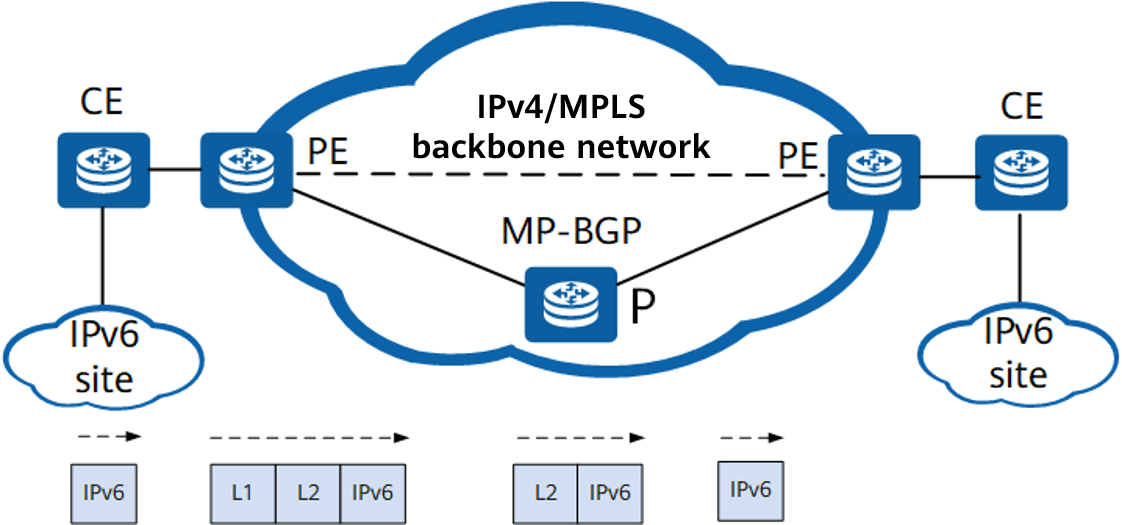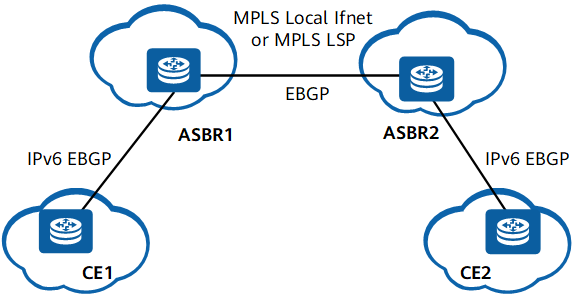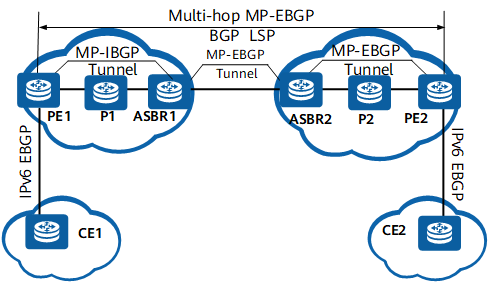What Is 6PE? What Problems Does 6PE Solve?
IPv6 Provider Edge (6PE) is a technology that facilitates IPv4-to-IPv6 transition based on Multiprotocol Label Switching (MPLS). 6PE enables isolated IPv6 networks to communicate using MPLS LSPs on an IPv4 MPLS backbone network. It improves the utilization of MPLS network resources without affecting existing services.
Why Do We Need 6PE?
Various solutions, such as tunneling and dual-stack technologies, are proposed to facilitate network evolution from IPv4 to IPv6, enabling IPv6 traffic to be carried on the original IPv4 network. 6PE is a transitional IPv6 over IPv4 technology that uses MPLS tunnels to carry services. If the original bearer network is based on MPLS, 6PE can be used to facilitate IPv4-to-IPv6 evolution.
IPv6-oriented MPLS Network Evolution
During the early stage of IPv6 network development, such networks carry few services and are like isolated islands in an ocean of IPv4 networks. When evolving an IPv4 network toward IPv6, use easy, simple, and cost-effective methods to achieve smooth evolution. Ensure that the existing IPv4 services can run properly during this process.
No mature IPv6 label distribution protocol is available for MPLS networks. As a result, directly allocating labels to IPv6 prefixes for IPv6 data forwarding is difficult. Against this backdrop, the transitional 6PE solution is proposed.
6PE uses one protocol to carry the services of another protocol, enabling service interworking across different domains. 6PE is widely used during the evolution of backbone and metro networks. Metro networks differ from backbone networks in that IPv4 MPLS networks may span multiple ASs during 6PE deployment.
Benefits of 6PE
6PE offers the following benefits:
- Easy maintenance: All configurations are performed on PEs connected to user-side devices, and the IPv6 networks are unaware of the IPv4 network. Using an existing IPv4 network to carry IPv6 services simplifies maintenance and facilitates progressive network deployment.
- Low network construction costs: 6PE fully utilizes existing IPv4 MPLS tunnels to provide IPv6 services for users, eliminating the need to upgrade the network. 6PE devices can provide multiple types of services, such as IPv6 VPN and IPv4 VPN.
What Types of 6PE Exist?
In real-world situations, different metro networks of a carrier or backbone networks of collaborative carriers often span multiple ASs. 6PE is classified as either intra-AS 6PE or inter-AS 6PE, depending on whether separate IPv6 networks connect to the same AS. The following describes 6PE networking.
6PE Networking
Intra-AS 6PE is used to connect separate IPv6 networks to the same AS, whereas inter-AS 6PE is used to connect separate IPv6 networks to different ASs. Inter-AS 6PE can be further classified as inter-AS 6PE Option B or inter-AS 6PE Option C. Each type of 6PE has its own advantages and application scenarios. The following describes the basic types of 6PE.
- Intra-AS 6PE
As shown in the following figure, separate IPv6 networks connect to the same AS. PEs in the AS exchange IPv6 routes through MP-IBGP peer relationships.
PEs and CEs use the IPv6 routing protocol to exchange IPv6 routing information. On a 6PE network, three types of devices exist: provider (P), provider edge (PE), and customer edge (CE).
- Ps are backbone devices on the 6PE network. Generally, Ps are the backbone devices of a service provider. They do not connect to any CE and must have basic MPLS forwarding capabilities.
- PEs are edge devices on a 6PE network. Generally, PEs are edge devices on the backbone network of a service provider. PEs connect to both CEs and Ps and are important network devices.
- CEs are edge devices on the customer network. These devices directly connect to a service provider network through interfaces. CEs can be routers, switches, or hosts. Generally, CEs do not need to support MPLS.
PEs exchange IPv6 routing information through Multiprotocol Extensions for Border Gateway Protocol (MP-BGP) and add two MPLS labels to IPv6 packets. The inner label (L2) corresponds to the IPv6 prefix, and the outer label (L1) corresponds to the LSP between 6PE devices.
PEs and Ps use the IPv4 routing protocol to exchange routing information, and PEs use MPLS to establish LSPs with each other. IPv6 traffic is transmitted over the IPv4 MPLS core network based on MPLS labels.
Intra-AS 6PE networking - Inter-AS 6PE Option B
- In this inter-AS 6PE Option B scenario, autonomous system boundary routers (ASBRs) also function as PEs. This scenario is similar to the intra-AS 6PE scenario, except that PEs (ASBRs) exchange IPv6 routes through MP-EBGP.
Inter-AS 6PE Option B networking (with ASBRs also functioning as PEs) - In this inter-AS 6PE Option B scenario, ASBRs do not function as PEs. On the network shown in the following figure, IPv4 routing protocols are used to exchange labeled routes between PEs and ASBRs and between ASBRs. Tunnels need to be set up between PEs and ASBRs in the same AS and between ASBRs to transparently transmit IPv6 packets.
Inter-AS 6PE Option B networking (with ASBRs not functioning as PEs)
- In this inter-AS 6PE Option B scenario, autonomous system boundary routers (ASBRs) also function as PEs. This scenario is similar to the intra-AS 6PE scenario, except that PEs (ASBRs) exchange IPv6 routes through MP-EBGP.
- Inter-AS 6PE Option C
In an inter-AS 6PE Option C scenario, a PE establishes a multi-hop MP-EBGP peer relationship with the peer PE and exchanges labeled routes with it using an IPv4 routing protocol. PEs transparently transmit IPv6 packets to each other over E2E BGP LSPs.
Inter-AS 6PE Option C networking
How Does 6PE Work?
Simply put, 6PE adds two MPLS labels to IPv6 packets, so that these packets can be correctly forwarded to the destination across the IPv4 core network. The way in which 6PE works can be divided into two aspects. On the control plane, 6PE allocates MPLS labels to IPv6 routes based on MP-BGP, whereas on the forwarding plane, it forwards IPv6 packets based on outer MPLS labels.
6PE Control Plane
The following figure shows the working principles of 6PE on the control plane. IPv4/IPv6 dual stack needs to be deployed only on PE1 and PE2, and other devices can continue to use IPv4 single stack. PE1 and PE2 use MP-BGP to advertise IPv6 routes. CEs and Ps do not have IPv6 information — they only have the IPv4 routing table and label forwarding information base (LFIB).
The IPv4 address of PE1 is 1.1.1.1, and that of PE2 is 2.2.2.2. PEs must support IPv4/IPv6 dual stack. An IPv4 address must be configured on the IPv4 MPLS network side, and an IPv6 address must be configured on the IPv6 user side.

Working principles of 6PE on the control plane
- CE1 advertises two IPv6 routes (Route1 and Route2) to PE1, which in turn advertises them through MP-BGP to PE2. As shown in ①, each route must carry the following key information:
- Inner label value XXX for Layer 2 MPLS encapsulation of IPv6 packets.
- Next hop address ::FFFF:1.1.1.1 for Route1 and Route2. ::FFFF:1.1.1.1 is an IPv6 address mapped from PE1's IPv4 address. It is a special IPv6 address automatically mapped by 6PE, not an IPv6 address on the CE side of the 6PE device. When encapsulating an IPv6 packet, the 6PE device obtains the IPv4 address of the egress PE based on this address and obtains the outer MPLS label value based on the IPv4 address.
- Similarly, CE2 advertises two IPv6 routes (Route3 and Route4) to PE2. The two routes carry the key information IPv6 label YYY and the IPv6 address mapped from the IPv4 address ::FFFF:2.2.2.2, as shown in ②.
- PE1 and PE2 generate a global IPv6 routing table based on the IPv6 routing information advertised by BGP, as shown in ③.
Packet Forwarding on a 6PE Network
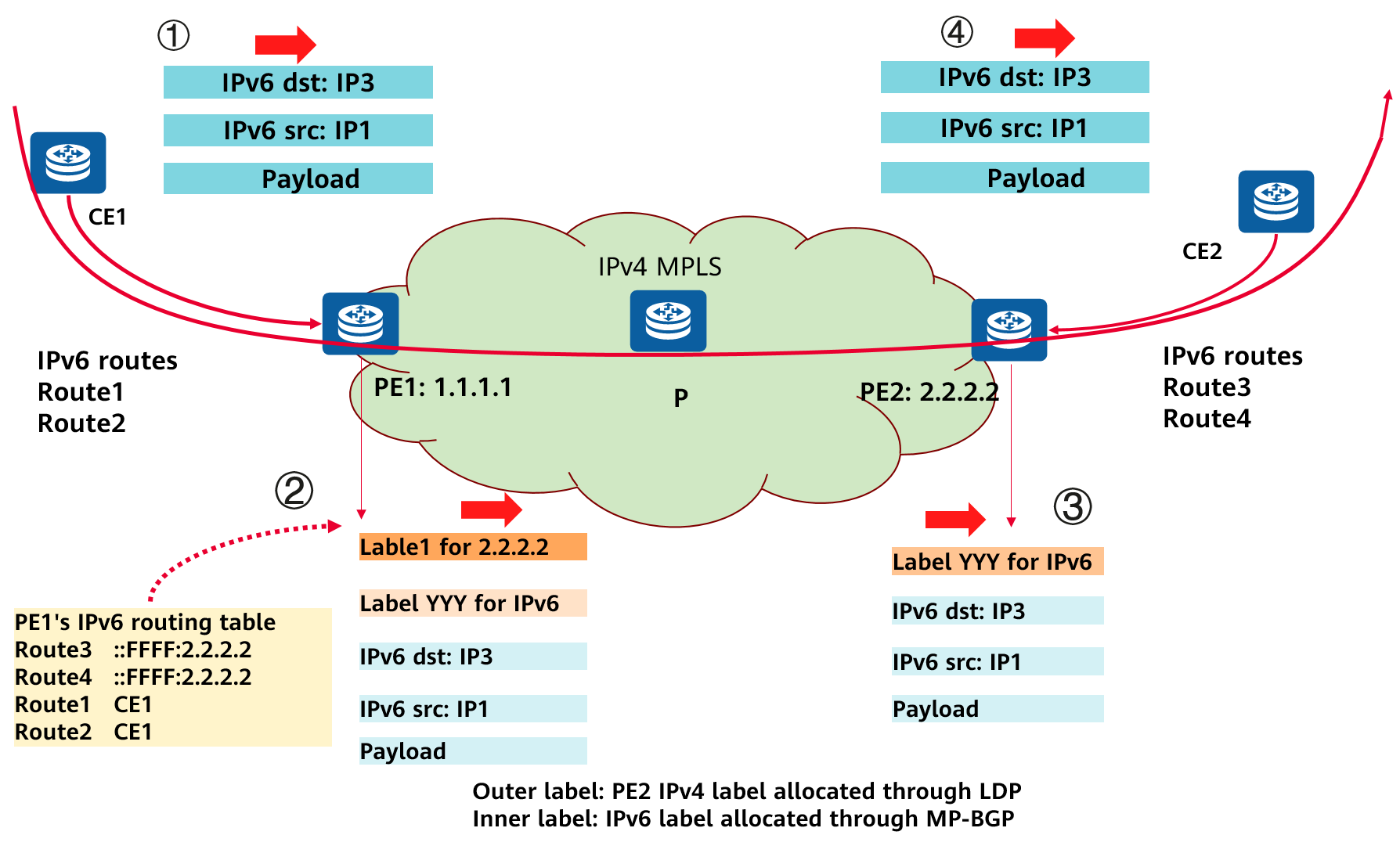
Working principles of 6PE on the forwarding plane
In 6PE networking, IPv6 route advertisement consists of the following four steps:
- After receiving an IPv6 packet from CE1, PE1 searches its local IPv6 routing table based on the destination address IP3 in the IPv6 packet. As shown in ②, the destination address IP3 matches the first entry in the routing table, and the corresponding next hop is IPv6 address ::FFFF:2.2.2.2 mapped from PE2's IPv4 address.
- PE1 derives the next hop IPv4 address 2.2.2.2 based on this address, obtains the public network tunnel label Label1 based on IPv4 address 2.2.2.2, and obtains the inner label YYY based on information advertised by MP-BGP. After encapsulating the IPv6 packet with the two layers of MPLS labels, PE1 forwards the packet to the backbone network.
- Penultimate hop popping (PHP) is used in this example to keep the description concise. As shown in ③, when the IPv6 packet encapsulated with double labels passes through the P, the outer label is popped out according to PHP. When the packet reaches PE2, only the inner label YYY advertised by MP-BGP is left.
- As shown in ④, PE2 searches its global IPv6 routing table based on the inner label YYY and matches the IPv6 address IP3 following the longest match rule to find the IPv6 route and next hop to CE2.
To sum up, after receiving an IPv6 route advertised by a CE on the same IPv6 network, a 6PE device allocates an outer MPLS label to the route and advertises the route to the peer 6PE device through MP-BGP. The peer 6PE device accepts the route, retains its VPN label, and changes the route's next hop attribute to be the IPv6 address mapped from a local IPv4 address. The device then advertises the route as a common IPv6 route to the IPv6 CE on the local side. In this way, the two IPv6 networks complete route exchange.
What Are the Differences Between 6PE and 6VPE?
6PE places all IPv6 networks connected through 6PE into the same VPN and cannot logically isolate them. As such, 6PE can be used to interconnect only open, unprotected IPv6 networks. To ensure logical isolation between connected IPv6 networks through IPv6 VPN, IPv6 VPN provider edge (6VPE) is required.
6VPE is a VPN technology that connects private IPv6 sites through an IPv4 public or backbone network while ensuring isolation between the services of private IPv6 sites belonging to different users. Compared with 6PE, 6VPE introduces the VPN-IPv6 address family and VRF-IPv6 to implement logical isolation between different VRF-IPv6 networks, improving IPv6 network security.
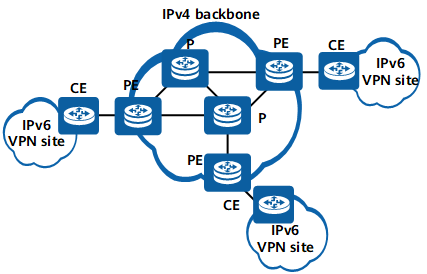
6VPE network structure
6VPE uses L3VPN to establish an independent VPN for IPv6 services. The original MPLS L3VPN side can carry only IPv4 single-stack traffic. After MPLS L3VPN IPv4/IPv6 dual stack is enabled, VPN-side IPv4 and IPv6 traffic can both be carried over MPLS tunnels.
- Author: Huang Huixian
- Updated on: 2021-09-30
- Views: 9666
- Average rating:




